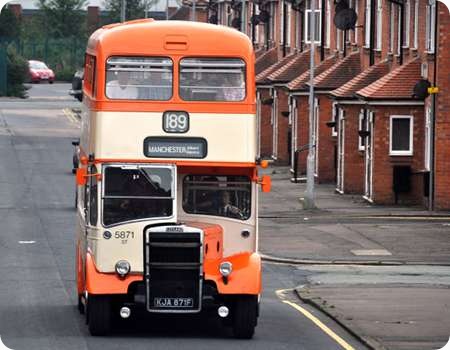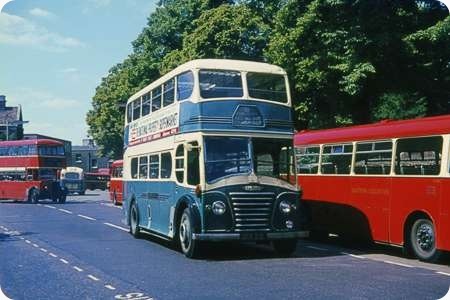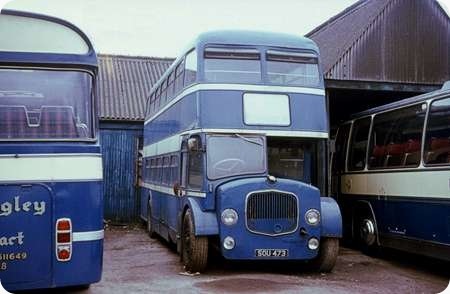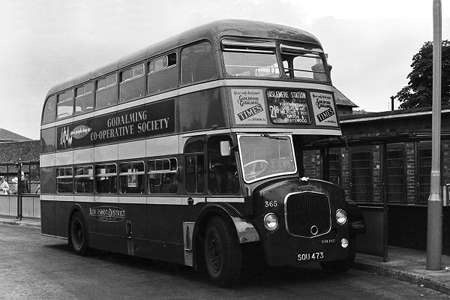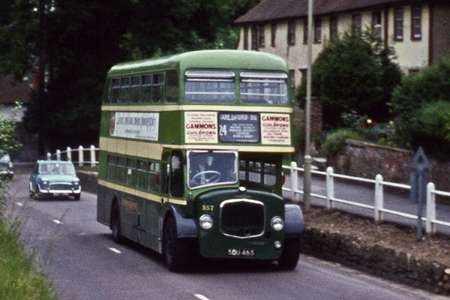Stockport Corporation – Leyland Titan – KJA 871F – 71/5871
Stockport Corporation
1968
Leyland Titan PD3/14
East Lancs H38/32R
KJA 871F is a Leyland Titan PD3/14 with East Lancs H38/32R body, new to Stockport Corporation as their no. 71 in February 1968. It is preserved at The Manchester Museum of Transport in Boyle Street, Cheetham Hill. Greater Manchester. The museum is next to an operational bus garage.
It is photographed on 24/7/10 returning to the museum on a shuttle service from Heaton Park, during a running day linking the museum and the tram system at Heaton Park. It is preserved in SELNEC livery.
Photograph and Copy contributed by Ken Jones
26/03/13 – 16:17
Stockport’s second attempt at something "new fangled"!!
After years of almost dedicated conservatism Stockport dipped their toe into the second half of the twentieth century with this, the first of their first batch of 30 foot long double deckers. Apart from the length, nothing else changed. Rear open platform, East Lancs bodies with wind down windows and draught/drip strips.
Still a magnificent vehicle and one of the few body styles to really look good in SELNEC orange.
As a matter of interest, Stockport’s first attempt at modernity was the inclusion of translucent roof centres from 1964 onwards.
Phil Blinkhorn
26/03/13 – 17:17
…..but they did try tin fronts on the 1958 Crossley bodies – and finally went mad and had a batch of forward entrance PD3s…..
David Oldfield
27/03/13 – 06:55
The livery is an abomination compared with that which it bore before the advent of SELNEC and the blinds are totally unsuited to the apertures but as an example of the way that presentational standards dropped during the ’70’s it is perfect.
Actually, Stockport’s first attempt at modernity was the trolleybuses of 1913 but perhaps that experience persuaded the Transport Dept to draw in it’s horns thereafter though they did order several TD4c’s as tramway replacements …. adventurous by their standards!
Truth is that conservatism paid for Stockport. They got a standardized fleet of reliable vehicles and ran a profitable organization even though most of their vehicles were two man operated and they had the advantage of lower dwell times that omo fleets. Mind you, I should have hated to have to drive a PD3 for a living!
Orla Nutting
27/03/13 – 06:56
The SELNEC orange and white has had a lot of bad press amongst enthusiasts. I think this was largely because it replaced a lot of cherished and varied municipal liveries in the area. In itself I thought it was not unattractive and in some instances was an improvement on the previous municipal scheme. I quote as an example Rochdale’s dreadfully bland all over cream with a bit of blue which was adopted for spray painting in the early 1960’s. The majestic Weymann bodied Regent V’s looked much better to me in SELNEC livery. It was really designed for rear engined buses and did generally sit uneasily on front engined double deckers particularly where an exposed radiator was used. One thing in SELNEC’s favour was that it went for something new and did not favour any of the previous liveries of any of the constituent operators. West Midlands got a watered down Birmingham livery for example with no recognition of the other three operators involved. The same applied on Tyneside with South Shields not getting a look in.
Philip Halstead
27/03/13 – 12:17
Orla has a good point about the trolleybuses, especially as they were Lloyd Kohler system of current transfer – a total dead end in the trolleybus world.
I’m not sure the tin fronts were an attempt at modernity. Leyland decided to standardise on the tin front and later St Helen’s fronts. For a period, there was a small premium for the traditional radiator. This coincided with Stockport’s tin front and St Helens front orders – so the adoption of these styles was typical of their monetary conservatism.
Philip restates a long held misunderstanding regarding the design of SELNEC’s livery. It was definitely not designed for rear engined vehicles, or even the SELNEC "Standards", the design of which had not been finalised at the time the livery was agreed.
In 1970 I had a meeting with Tony Harrison in his office in Peter House. On the window ledge was a range of bus models, some Corgi, some Dinky, some hand built and a mix of single deckers and front and rear engined double deckers in an array of colour schemes.
Whilst I was there for another reason to be revealed in an article in due course, I asked Tony what they were for. As I found out later when he was my boss, he wasn’t the most patient man but he told me they had been used when the livery was designed and he gave me chapter and verse on how the SELNEC Board were frustrated by what at the time was a negative public and media reaction to the scheme.
He told me that they had decided to avoid any reference to any of the constituent Transport Departments’ colours and had looked to have designed a layout between the orange and warm white which would look balanced on any vehicle even when side advertising was applied.
Stuart Brown in "Greater Manchester Buses" states correctly that the orange band above the lower deck windows was not to be more than 12 inches deep and the white on the between decks panel was to be fixed at 26 inches.
This is where the misapprehension regarding the scheme being designed for rear engined vehicles arises. Whilst the "Standard" design hadn’t been finalised when the dimensions of the scheme were worked out, the dimensions were exactly those of the Northern Counties "Standard" but not of the Park Royal version, which had a deeper between decks band.
At the time they had expected to keep rear entrance double deckers until the end of the 1970s, given the slow delivery rate from the Leyland group so needed a scheme to cover all types. The initial scheme the designers came up with was the Mancunian scheme with the white replaced by orange and the red by white. There was a model of a rear entrance bus in Tony’s office in that scheme and it look terrible, particularly around the rear nearside, though it looked a little better on a rear engined model. It was quickly rejected.
Once real vehicles were painted two things became apparent. With certain types, keeping to the dimensions made some bodies look ungainly. The difference in depth of the orange below the upper deck window line due to window depth, to maintain the 26 inches between decks white dimension, gave the impression of random application when different bodies were seen together.
Secondly, after a short period of time, different paint shops decided to vary the application to suit certain body styles. The Northern Division was the worst offender. Bury’s MCW bodied Atlanteans were painted almost correctly but almost identical Bolton versions had different paint dimensions and Bolton’s East Lancs bodied Atlanteans had different versions almost batch by batch. Bolton’s MCW front entrance PD3s had a unique version of the Orion scheme with virtually no orange under the windows making the between decks white very wide.
What had been intended as a non-partisan, unifying scheme rapidly descended into something resembling a visual disaster.
Phil Blinkhorn
27/03/13 – 12:18
Although Stockport had a conservative vehicle-buying policy and never operated a rear-engined double-decker, a batch of Bristol VRs was being built for them at the time of SELNEC’s formation but a fire at the factory destroyed them all before delivery.
This must have been the East Lancs factory in Blackburn. Someone will know more! There is a story that at least one of the chassis ended up in New Zealand.
Geoff Kerr
27/03/13 – 16:47
The fire was at the East Lancs Blackburn factory. The full story will appear on this Forum shortly. One VRT chassis was certainly saved in complete form and ended up in Woollagong Australia with a locally built body. It’s been stated that of the rest, those that could be salvaged were broken for spares.
There is a story that Daw Bank would not have received the vehicles and that they would have been sent to Leigh where they would have been used to introduce OMO service, their lower height would have allowed them to be stabled in the old Corporation depot.
Phil Blinkhorn
28/03/13 – 06:49
Philip H mentions South Shields not getting a look in with the new T&W PTE livery, Sunderland were in the same boat. T&W decided that their livery would be based on the yellow of Newcastle Corporation, they went through several different permutations before they eventually settled for something not a million miles from where they started. The change would have been obvious to anyone living in South Shields or Sunderland, whereas most people in the Newcastle area would hardly be aware that the livery had changed.
Ronnie Hoye
28/03/13 – 06:49
In a recent edition of ‘Classic Bus’ there was a brave attempt by Mike Eyre based on Soton buses to interpret what the VR’s would have looked like had they made it to Stockport including mock ‘J’ registrations in the JA series. Unfortunately I think the answer is ‘ugly’ especially with the treatment of the radiator grills and had they gone to Leigh I should not have wept.
Orla Nutting
28/03/13 – 07:57
Orla, I haven’t seen the Mike Eyre attempt but I can say two things with certainty based on seeing the first of the batch complete and painted. The vehicles would have looked very much like any other East Lancs rear engine design, similar to the last Bury Atlanteans and Fleetlines plus radiator grilles a la the delivery of VRs to Sheffield in 1972.
As Mike’s attempt was based on Southampton, I assume you mean the livery layout. Of course the bus was painted in full SELNEC colours but no logo or legal lettering had been applied when I saw it so the veracity of the Leigh story cannot be confirmed. The front indicator layout was standard SELNEC with a number indicator in the usual SELNEC nearside position.
My East Lancs’ contact promised to look out the correspondence with Stockport regarding livery for my subsequent visit. My contact said he seemed to remember they had been asked to quote for both the traditional Stockport layout and a revised layout based on that supplied on the Leopards. There seems to have been a division of opinion in the Stockport Transport Committee regarding the Leopard scheme. He did comment that the traditional layout cost a few pounds more per bus due to the extra masking and lining out.
Of course my subsequent visit never materialised as the fire intervened, destroyed their records and lost me an order for SELNEC!
Phil Blinkhorn
29/03/13 – 06:50
The first attempts at modernising the look of the early rear engined double deckers fell broadly into two camps: the peak and angle treatment (Liverpool and Bolton) and the curves (e.g. most Alexanders, plus other builders using Alexander features). Unfortunately by 1970 the standard offering from East Lancs had a foot in each camp, with a peaked dome above a curved windscreen, which always jarred with me. This is the version which Mike Eyre used as the basis for his image. The curved windscreen was not obligatory, however – the Sheffield VRs didn’t have it, and neither did the Fleetlines ordered by Bury and delivered to SELNEC. As for the grill on the Sheffield VRs, the attempt to hide it rather than make a feature of it was not a clever idea, although I’m sure it must have saved a few quid!
Peter Williamson
29/03/13 – 08:54
Peter, this is the body style used on the "Stockport" VRs: www.sct61.org.uk/
Move the staircase forward to the standard front entrance position and add the grille and you have the bus as I saw it.
Phil Blinkhorn
29/03/13 – 08:55
The Sheffield East Lancs bodied VRs were withdrawn by the PTE as non-standard in the late seventies They went on to have long lives with various NBC companies notably Crosville and Hastings & District In late 1974 one was on loan as a demonstrator to West Yorkshire PTE I saw it working the Bradford-Halifax service New VRs did not figure on WYPTE orders but its successor Yorkshire Rider ran many after they absorbed West Yorkshire Road Car in 1990.
As well as Sheffield Merseyside PTE also ran some East Lancs bodied VRs
Chris Hough
31/03/13 – 07:42
The Sheffield VR loaned to West Yorkshire PTE in 1975 was fleet number 275. It was a swap with WYPTE AN68 6003 which was fitted with Leyland G3 automatic gearbox control which SYPTE wished to try. Engineers from Dennis had a look at the drive train of the VR whilst it was at Halifax when they were designing the Dominator (ie how NOT to design a drive train!)
Ian Wild
Quick links to the - Comments Page - Contact Page - Home Page
